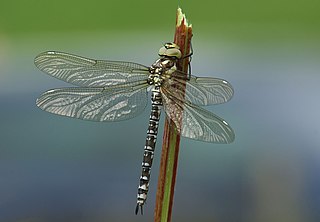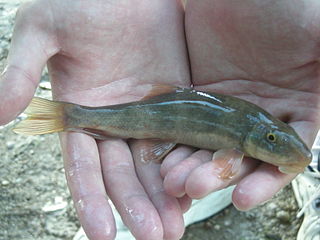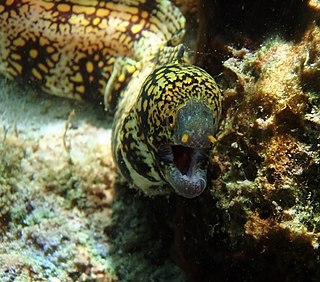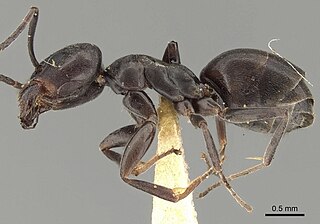
Trachodon is a dubious genus of hadrosaurid dinosaur based on teeth from the Campanian-age Upper Cretaceous Judith River Formation of Montana, U.S. It is a historically important genus with a convoluted taxonomy that has been all but abandoned by modern dinosaur paleontologists.

Desidae is a family of spiders, some of which are known as intertidal spiders. The family is named for the genus Desis, members of which live in a very unusual location — between the tides. The family has been reevaluated in recent years and now includes inland genera and species as well, such as Badumna and Phryganoporus. In 2017, the family Amphinectidae was merged into Desidae. The family Toxopidae has been separated off. Those intertidal spiders that are truly marine commonly live in barnacle shells, which they seal up with silk; this allows them to maintain an air bubble during high tide. They emerge at night to feed on various small arthropods that live in the intertidal zone.

Aeshna, or the mosaic darners, is a genus of dragonflies from the family Aeshnidae. Species within this genus are generally known as "hawkers" or "darners".

The blue petrel is a small seabird in the shearwater and petrel family, Procellariidae. This small petrel is the only member of the genus Halobaena, but is closely allied to the prions. It is distributed across the Southern Ocean but breeds at a few island sites, all close to the Antarctic Convergence zone.

Catostomus is a genus of fish belonging to the family Catostomidae, commonly known as suckers. This genus of fish usually lives in freshwater basins. Most members of the genus are native to North America, but C. catostomus is also found in Russia.

The snow petrel is the only member of the genus Pagodroma. It is one of only three birds that have been seen at the Geographic South Pole, along with the Antarctic petrel and the south polar skua, which has the most southerly breeding sites of any bird, inland in Antarctica.

The Megaspilidae are a small hymenopteran family with 13 genera in two subfamilies, and some 450 known species, with a great many species still undescribed. It is a poorly known group as a whole, though most are believed to be parasitoids, and a few hyperparasitoids. Many are found in the soil, and of these, a number are wingless.

Gradungulidae, also known as large-clawed spiders, is a spider family endemic to Australia and New Zealand. They are medium to large-sized haplogyne spiders with three claws and two pairs of book-lungs similar to Mygalomorphae. Some species build extensive webs with an upper retreat tangle and connecting threads to scaffolding. This supports the ladder-like catching platform that is glued to the ground. Progradungula, a large spider with long legs like Hickmania, and Macrogradungula are the only cribellate genera of the family.

The rock shag, also known as the Magellanic cormorant, is a marine cormorant found around the southernmost coasts of South America. Its breeding range is from around Valdivia, Chile, south to Cape Horn and Tierra del Fuego, and north to Punta Tombo in Argentina. In winter it is seen further north, with individuals reaching as far as Santiago, Chile on the west coast and Uruguay on the east. The birds also breed around the coasts of the Falkland Islands.

Echidna is a genus of moray eels in the family Muraenidae.

Porrhothele is a genus of mygalomorph spiders endemic to New Zealand. They are the only members of the family Porrhothelidae. They were first described by Eugène Louis Simon in 1892. Originally placed with the curtain web spiders, it was moved to the Hexathelidae in 1980, they were placed in their own family in 2018.

Tapinoma nigerrimum is a species of ant in the genus Tapinoma. Described by Nylander in 1856, the species is endemic to Africa and Europe.

This timeline of hadrosaur research is a chronological listing of events in the history of paleontology focused on the hadrosauroids, a group of herbivorous ornithopod dinosaurs popularly known as the duck-billed dinosaurs. Scientific research on hadrosaurs began in the 1850s, when Joseph Leidy described the genera Thespesius and Trachodon based on scrappy fossils discovered in the western United States. Just two years later he published a description of the much better-preserved remains of an animal from New Jersey that he named Hadrosaurus.
Amblyaspis is a genus of parasitoid wasps belonging to the family Platygastridae.

Aphanus is a genus of dirt-colored seed bugs in the family Rhyparochromidae. There are more than 20 described species in Aphanus.
Isostasius is a genus of parasitoid wasps belonging to the family Platygastridae.
Isocybus is a genus of parasitoid wasps belonging to the family Platygastridae.
Leptacis is a genus of parasitoid wasps belonging to the family Platygastridae.
Mystrophorus is a genus of insects belonging to the family Dryinidae.
Sparasion is a genus of wasps belonging to the family Sparasionidae, whitin the superfamily Platygastridae. The genus has specimens widespread in Eurasia, Africa, and temperate North America.













